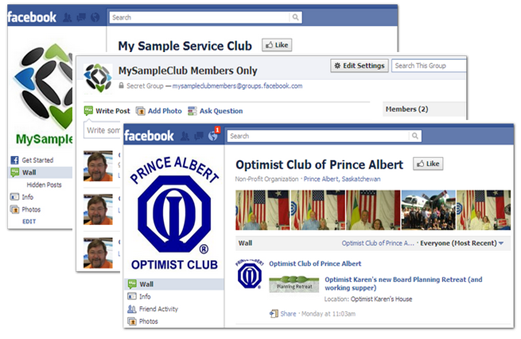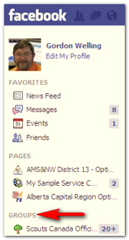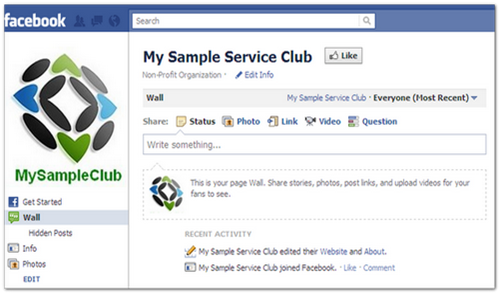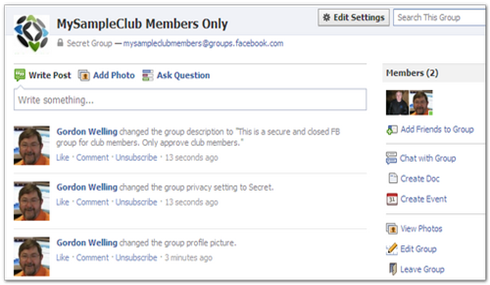
Facebook is all about community. It is easy to become a Facebook user, easy to use the service and allows people to engage one another using messages, chat, activity feeds, video, and static information. Facebook collects, stores and shares data by categorizing it, indexing it and making available to an internal search engine, and to public search engines like Google and Bing.
There are some important concepts to understand with Facebook, so let's discuss them now:
 Account - every individual is allowed one and only one Facebook account. To open more than one account violates the Facebook terms of service agreement. Violators can have their account closed and their data can be removed without notice. A user can create an account profile and can host many other Facebook entities, like pages and groups.
Account - every individual is allowed one and only one Facebook account. To open more than one account violates the Facebook terms of service agreement. Violators can have their account closed and their data can be removed without notice. A user can create an account profile and can host many other Facebook entities, like pages and groups. - Profile - each user’s account gets a profile, a personal write up that describes the individual who operates the account. A profile is personal and should not be used for a business, an organization, and a group.
- Group - is a controlled collection of users who can use a Facebook Group to share information and contact one another. Groups can be secret or secure or open. Groups include a rudimentary built-in documents app but do not support adding 3rd party apps like Facebook pages do. A Group is designed to allow members to collaborate, discuss a variety of topics and share ideas.
- Page - is a public entity that is used by people to share information. Pages have the same public visibility as normal websites. They are indexed by Facebook and public search engines. Everyone with web access can see the content of a Page. Facebook pages can be extended by adding 3rd party applications which add extra "tabs" to the page.
- Access and Participation - all entities have different levels of access:
- Accounts - users request to become a "Friend" and the receiving user must agree. This provides bilateral consent to share and exchange information.
- Groups - users are either invited and can request to become a "Member" of a Group. The admin or another Group member can accept the invitation (depends on how the Group permissions are configured).
- Secret Groups are not visible to Facebook search. Secret Group members must be logged in to see the Group and its content.
- Secure Groups are visible in Facebook search results but Group members must be logged in to see the content and post new content. Other Facebook users can see the group information but cannot contribute to the group.
- Open Groups are visible to Facebook and normal internet search engines and the content is available to any logged-in Facebook user.
- Pages - users "Like" a page that they want to interact with. Anyone can see the content of a Facebook page. Logged in Facebook users must "Like" a page before they can contribute to the page and share content on that page.
A service club can create a Facebook Page as a public presence on the internet. It is the most popular medium that permits your club members to interact with the general public. Facebook pages offer clubs a means to extend their message, causes, projects, fund raising efforts, and fellowship to their registered fans.

See our PDF Guide – Create a Facebook Page

See our Guide – Create a Facebook Group
PAGE or GROUP – HOW TO DECIDE
A Facebook Group can also be used instead of a Facebook Page as a public presence for your service club. The major differences between Pages and Groups include:
- Who can see the Facebook Presence – Facebook Pages are seen by everyone who has a web browser and internet access. Facebook Groups are more tightly controlled. If a Facebook Group is configured as a “Open” Group, it will be visible to anyone who is logged into Facebook.
Hint: If visibility to anyone on the internet is important, choose to create a Facebook Page. - Who can post content – Facebook pages require that an individual “Like” the page before they can post content to that page. Facebook Groups require that an individual “Join” the Group and be approved as a member before being able to post content. Facebook Groups have tighter controls for content publishing.
Hint: If you need to control who can post content to a registered list of Facebook users, choose to create a Facebook Group.
Hint: If you need to need to hide the Facebook presence from everyone except the approved registered Facebook users, create a “Secret” Facebook Group.. - Ease of set up – Facebook Groups are much easier and faster to set up and publish. Facebook Pages support more configuration options and can take considerably more time to set up and publish.
Hint: If you are not concerned with customizing the Facebook presence, choose to create a Facebook Group. - Which is easier to customize – Both Facebook Pages and Groups come with the core applications provided by Facebook. Pages can be customized by adding more Facebook applications. Facebook Groups do not support adding more applications so customizing a Group is very limited.
Hint: If you need to enable additional applications for your Facebook presence, choose to create a Facebook Page. - What about friendly URLs – Facebook Pages must garner 25 or more “Likes” before applying for a username which will convert the URL to something like www.facebook.com/username, like www.facebook.com/amsnwoptimist. Facebook Groups can immediately apply for a group email address which will convert the URL to something like www.facebook.com/groups/groupname like www.facebook.com/groups/mysampleclubmembers/.
Hint: If you need to immediately enable a friendly URL, choose to create a Facebook Group.
- Security is the primary factor – If all other factors are equal and security is the primary factor, choose to create a Facebook Group.
- Flexibility is the primary factor – If all other factors are equal and being able to add more features and applications is the primary factor, choose to create a Facebook Page.
- Visibility to Internet Search Engines is the primary factor – If all other factors are equal and making the Facebook presence visible to the Google, Bing, Yahoo and other internet search engines is the primary factor, choose to create a Facebook Page.
Here is a list of the rest of the "First Step" articles in this series:
- First Steps - Getting Your Club Online
- First Steps - Create a Generic Email Account
- First Steps - Create a Secure Portal with TeamLab (coming soon)
- First Steps - Create a Blog/Website with Blogger (coming soon)





